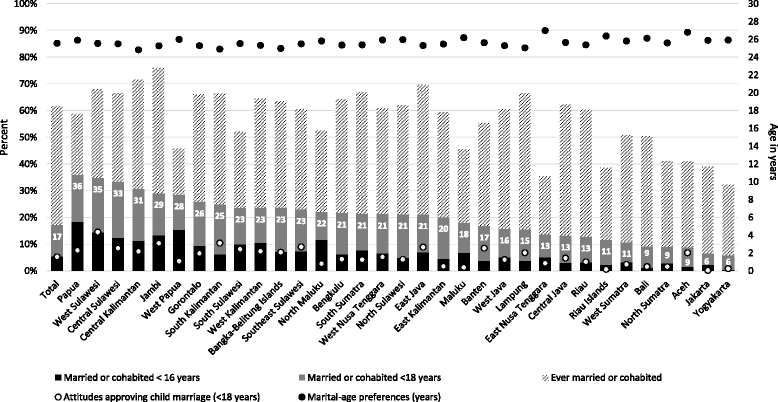An empirical exploration of female child marriage determinants in Indonesia
- PMID: 29587705
- PMCID: PMC5869762
- DOI: 10.1186/s12889-018-5313-0
An empirical exploration of female child marriage determinants in Indonesia
Abstract
Background: Child marriage, defined as marriage before age 18, is associated with adverse human capital outcomes. The child marriage burden remains high among female adolescents in Indonesia, despite increasing socioeconomic development. Research on child marriage in Southeast Asia is scarce. No nationally representative studies thus far have examined determinants of child marriage in Indonesia through multivariate regression modeling.
Methods: We used data from the nationally representative 2012 Indonesian Demographic and Health Survey and the Adolescent Reproductive Health Survey to estimate determinants of child marriage and marital preferences. We ran multivariate models to estimate the association between demographic and socioeconomic characteristics and the following early marriage outcomes: 1) ever been married or cohabited, 2) married or cohabited before 18 years, 3) married or cohabited before 16 years, 4) self-reported marital-age preferences and 5) attitudes approving female child marriage.
Results: Among the child marriage research sample (n = 6578, females aged 20-24 at time of survey), approximately 17% and 6% report being married before 18 and 16 years old respectively. Among the marital preferences research sample (n = 8779, unmarried females 15-24), the average respondent preferred marriage at approximately 26 years and 5% had attitudes approving child marriage. Education, wealth and media exposure have protective effects across marriage outcomes, while rural residence is a risk factor for the same. There are significant variations by region, indicating roles of religious, ethnic and other geographically diverse factors.
Conclusion: This research fills a gap in understanding of child marriage determinants in Indonesia. There appears to be little support for child marriage among girls and young women, indicating an entry point for structural interventions that would lead to lasting change. Future research efforts should prioritize rigorous testing of gender-transformative education and economic strengthening interventions, including cost-effectiveness considerations to better understand how interventions and policies can be leveraged to deliver on ending child marriage in Indonesia and globally.
Keywords: Adolescent transitions; Child marriage; Indonesia; Structural determinants.
Conflict of interest statement
Ethics approval and consent to participate
No ethical approval was required as we conduct secondary data analysis on publicly available and de-identified data.
Consent for publication
Not applicable.
Competing interests
The authors declare that they have no competing interests.
Publisher’s Note
Springer Nature remains neutral with regard to jurisdictional claims in published maps and institutional affiliations.
Figures

References
-
- United Nations Children’s Fund . Ending child marriage: progress and prospects. 2014.
-
- United Nations. Convention on the rights of the child. United Nations Treaty Series vol 1577. 1989. http://www.refworld.org/docid/3ae6b38f0.html. Accessed 7 Mar 2018.
-
- World Health Organization. Health for the World’s Adolescents: A second chance in the second decade. 2014. http://apps.who.int/adolescent/second-decade/. Accessed 7 Mar 2018.
Publication types
MeSH terms
LinkOut - more resources
Full Text Sources
Other Literature Sources
Miscellaneous

